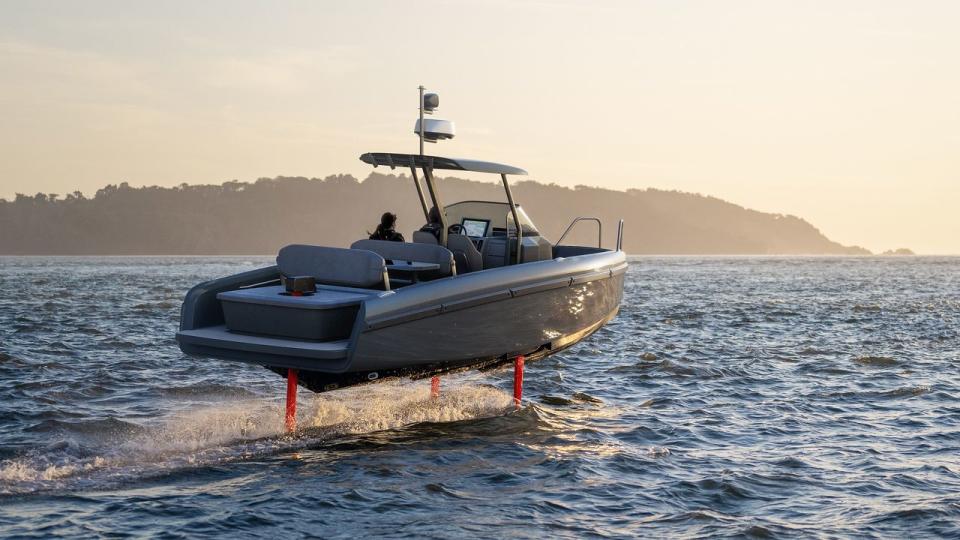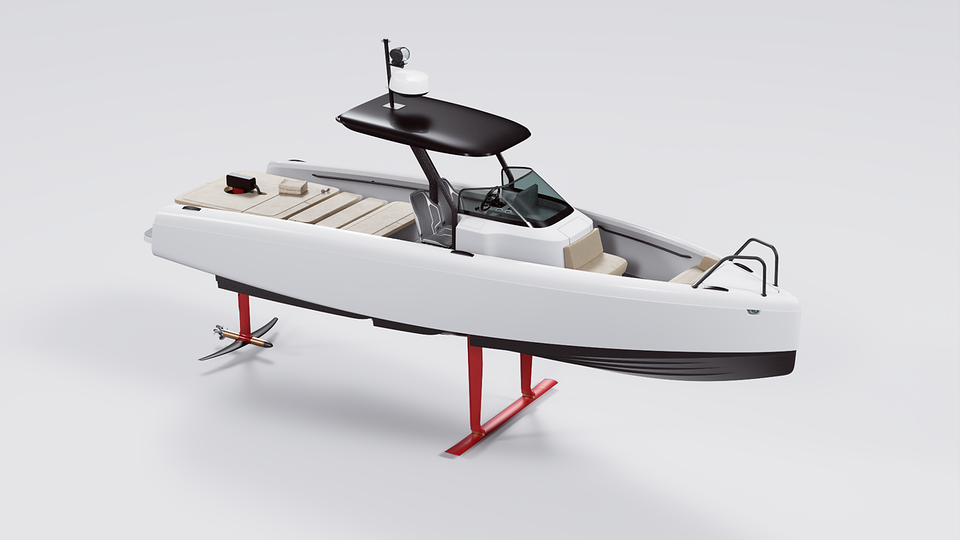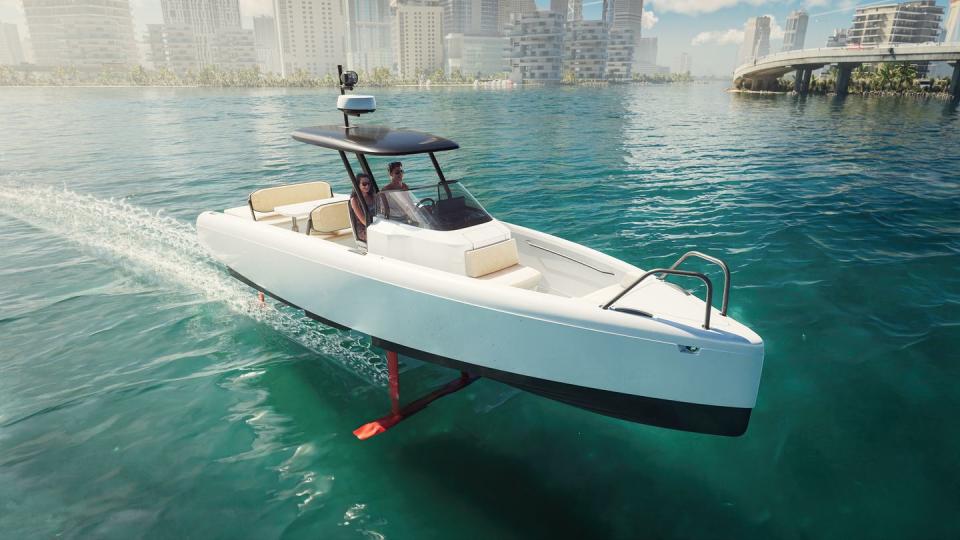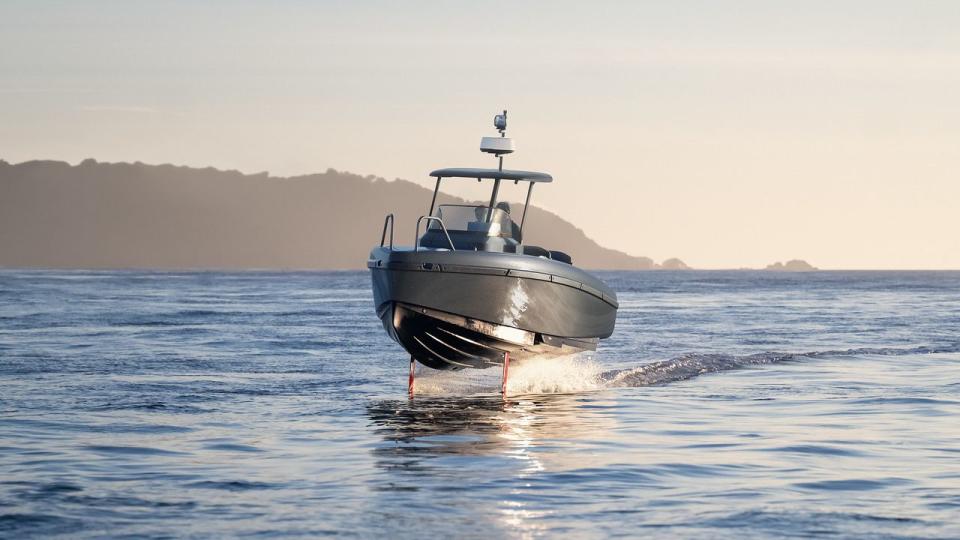Fly Over the Waves Like a Pterodactyl in the Candela C-8 Hydrofoil Electric Speedboat

The C-8 is an electric, carbon-fiber, hydrofoil boat that maximizes efficiency as it flies over the water.
It uses the 69-kWh battery pack from the Polestar 2.
Price is $395,000.
Ever since the first cave man stretched a yak skin over a bunch of curved sticks and made the first boat, not much has changed. Sure, there was the outboard motor—that was a big help. But the basic, generic, “boat” was still just a hole in the water (into which you pour money!) that allowed you to float.
That’s all about to change. Maybe.
Consider the hydrofoil. Hydrofoils are much more efficient than old-school “boats.” Your typical “boat” plows through water, shoving thousands of pounds of the heavy liquid out of the way in its plodding slog toward distant horizons.

This requires tremendous amounts of horsepower. Imagine lifting and throwing aside just one gallon of water, then imagine lifting and tossing aside thousands of gallons of water per second. That’s what the traditional boat hull has to do.
A hydrofoil rises above all that. Once a hydrofoil gets up to a certain speed—say 12 knots or so—it lifts up and out of the water, so the amount of water displaced per foot of forward progress is almost negligible.
How Does It Work?
Of course you remember Bernoulli’s Equation Po = P1 + ½rv1² + rgy1 = P2 + ½rv2² + rgy2, where Po equals stagnation pressure (Pa or lbf/ft2), etc. No need to wade through all that again, you already know it. The idea is efficiency, and hydrofoils have it in spades. Or foils.
Foils lower down into the water fore and aft, you crank the electric motors and, using Bernoulli, the foils create lift, like an airplane wing, with minimum drag, and lift the boat out of the water. If you don’t have to push all that water out of the way, resistance plummets. The C-8 uses as much power foiling at 19 knots as it does plowing through the water at 4 knots. It’s like the difference between flying and trying real hard to run as fast as you can while carrying all your waterskiing gear. It’s great.
But no one has taken this efficiency and put it into a boat that just about any semi-affluent boater could afford. Sure, there are a few hydrofoil ferries operating here and there around the world. But something the average Joe Boat Owner could buy for the price of a well-equipped Bentley? Not out there.
Until now. A Swedish company called Candela is well into its second hydrofoil boat model, the C-8, followup to the (you guessed it) C-7, and on sale right now. The C-8 is 100% electric. It’s 28 feet long, 8.2 feet wide (“The Beam,” for all you pirates), and weighs just 3858 pounds, including its 69-kWh battery.
The battery comes from fellow Swede Polestar (which is part of Volvo, which is part of Geely). In fact, it’s the same battery you’ll find in the Polestar 2 electric car, which makes perfect sense—why reinvent the battery? Just build the boat around it.
Those 69 kWh are charged on the dock via 11-kW 3-phase AC charging or via the Polestar DC charging if you’re in a hurry. They say they are working with docks across America to install chargers, but you can just plug yours in at your home dock. All marinas have power outlets at their docks already, don’t they?

The 69-kWh battery is good for 57 nautical miles of cruising, or 65.6 land miles for you landlubbers. That’s at 22 knots cruising speed, or 25.3 mph. Top speed is 30 knots, or 34.5 mph. So, from Los Angeles Harbor it’ll get you to Catalina and back, for instance. Or from Woods Hole to Martha’s Vineyard. Or from Monte Carlo to St. Tropez. But not from West Palm Beach to Freeport.
The two foils retract from below when docked or when cruising through the shallows, Minimum draft is just 1.6 feet. It’s just under three feet when the foils are deployed, but once you get under way and the boat lifts out of the water you’re only drawing just over two and a half feet.
The front foil is about as wide as the boat, while the rear foil is more like a very large boomerang with the electric motor inline in the middle and the two highly efficient counter-rotating props aft of that.
“It looks like a big torpedo,” my Candela host said of the assembly.

The Boat Ride: Curses Foiled Again!
The Polestar people have established a presence in Sausalito, California, on the shores of San Francisco Bay. They use it for R&D and to take potential buyers out for a spin. So I went.
When it’s tied up at the dock, the Candela C-8 looks like any other boat. You can’t tell it’s carbon fiber, and you can’t see the hydrofoils unless you dive under the water. I was getting into production boat number 14. Candela has delivered between 17 and 20 boats to customers so far, depending on whom you ask.
At the dock, and pulling away from the dock, it’s like a normal boat, albeit all-electric. When we get out into San Francisco Bay, the guy running things (not me) took speed up to four knots, the foils went down, then he pushed the throttle lever forward and the boat sped up.
It rose out of the water, and we are sailing along like a low-flying carbon-fiber pterodactyl! But then, suddenly, the C-8 jerked left and splashed down onto its starboard side with a huge ker-sploosh. We stopped, dead in the water.
We did not capsize (I’ve been on boats that have capsized), but it was a fairly attention-getting experience. The captain and the Candela rep poured over the large digital screen full of data. They showed me the data, which was like showing me Bernoulli’s equation.
Then we tried again. Up. FLYING! Kersplash! We crashed again. We tried this several more times, flying for a maximum of about 15 or 20 seconds before the whole rig dropped onto its starboard side like one of those breeching right whales you see on the YouTube videos.
After a while we gave up and headed back to the dock. Everyone was officially perplexed as to why this might have happened. Later, I was told the problem was the small electric motor that deploys the forward foil on the port side. I was told they swapped that out and that everything worked just fine the rest of the day.
"Our engineers have now looked into what malfunctioned and the problem was that the port actuator, that is the electric motor controlling the angle of attack of the foil, stalled, thereby making the vessel unable to fly," said a Candela rep. "We have seen this before once on a Swedish R&D boat, and the error is coupled to an early batch of actuators we received and which are now swapped to a new batch for production boats."
So everything's fine! I was offered another ride but it would have required another flight to SFO and another entire day of getting there and back. So I am left to assume everything’s just fine with the Candela C-8, that this was a once-in-a-lifetime occurrence, and that when you buy your C-8 it will work flawlessly.
But keep in mind, the Candela doesn’t work well in big waves. I am told one meter (3.3 feet) is the maximum height. The waves in San Francisco Bay were a lot less than one meter. They say it works great in places like Lake Tahoe, or the inland waterways of Stockholm, where the water is always flat.
And then there’s price. It’s listed on the Candela website at $395,000 for the Daycruiser model I experienced, with a little cabin in the bow. That includes delivery anywhere in the US. That price is a lot more than your typical “boat.” But then, the C-8 is all carbon fiber, all-electric, and it flies. Most boats can’t do that.
Candela is also working on various hydrofoil electric ferry boats that can seat up to 30 people, which would make the trip from Sausalito to San Francisco fun, maybe even thrilling. As long as the foil doesn’t collapse.

 Yahoo Autos
Yahoo Autos 